Abstract
Distortion (1), residual stresses and hot cracks can facilitate significant decreases in quality characteristics of casting products. Their reduction by a suitable component design (2) and process control is therefore desirable. In the casting process, these characteristics are assumed as a result of the combination of solidification shrinkage paired with the local self-feeding and the geometric constraints imposed on the component by the mold. In gravity die casting (3) of aluminum (4) with thermally well conducting and rigid metal molds, the control of solidification through a localized adjustment of the heat balance (5) appears to be a suitable approach to minimize these effects. The development of an experimental setup for the assessment of the interdependencies of the alloy, casting geometry and cooling are described in this work. A first series of experiments with A356 aluminum alloy and the introduction to the different methods of evaluation are presented. Furthermore, an approach to improve the understanding of the underlying mechanisms is outlined.
1. Introduction
Distortion, residual stresses, and hot cracks are decisive quality characteristics of cast parts and, depending on their characteristics, facilitate the need for additional finishing steps and rejects. Therefore, the reduction of these defects by a suitable component design and process control is of great interest for a cost-efficient production. In casting processes, these characteristics are assumed to be the result of a combination of solidification shrinkage, which is paired with the respective local self-feeding and the geometric constraint imposed by the mold on the component. In gravity die casting with thermally well conducting metal molds with a high rigidity, the manipulation of solidification through local control of the heat balance appears to be a suitable measure for reducing the above-mentioned quality-reducing variables.
The work presented here was carried out within the framework of the Collaborative Research Centre “Precision Melt Engineering”. The long-term goal of this sub-project, on which the work presented here is based on, is to improve component precision in permanent mold casting by creating a knowledge base in the areas of distortion and hot cracking, and furthermore, the development of corresponding concepts for their prediction, influencing, and minimization. The heat transfer coefficient (HTC) between mold and component, which has already been considered as a possible major influencing factor, was analyzed in this project in several separate studies [1,2,3]. In addition to these primarily experimental studies, in closely related subprojects, the working group is developing numerical methods to advance the coupled thermomechanical simulation on both the macroscale and the microscale [4,5]. An algorithm for optimizing the cooling channel layout to the local cooling requirements in plastic injection molding is developed in another sub-project. This is based on the hypothesis that a homogeneously solidifying component develops the lowest distortion [6]. This approach, originally developed for plastics in injection molding, was transferred to metal casting in a numerical framework and its applicability was evaluated. A recognizable potential became apparent as well as limitations in transferability, which are to be expected due to strongly differing thermophysical material properties between plastics and metals [7].
Various aspects of the underlying research work have already been addressed in the past: for example, the topic of in-situ measurements of the solidification shrinkage and the resulting forces on the mold for aluminum in sand casting [8,9]. Related investigations of the solidification shrinkage of aluminum alloys in permanent graphite molds were carried out [10], and the results were compared with numerical simulations [11]. The common feature in these studies was the “T” shape design of the specimen, with one side fixed in the mold in a form-fitting manner and the shrinkage or the force caused by this measured on the other side. For steel casting in sand molds, comparable methods were used [12] and extended to the in-situ measurement of the resulting distortion as the opening width of a “U” and also compared with simulations [13]. Component distortion and various possible criteria for its objective evaluation were considered purely on the basis of simulations [14,15] and compared with experimental results [16]. An investigation on the development of distortion and residual stresses in aluminum high pressure die casting for different alloys and geometries both numerically and experimentally was carried out [17]. It was found that the influence of the heat balance in the mold and after demolding has a large influence on the final distortion. Further, it was stated that the documented knowledge base on the occurrence of component distortion in permanent mold casting is not very pronounced. The above experimental work on gravity die casting only considers shrinkage (mainly one-dimensional) and not the resulting distortion of the part due to mold constraints. In contrast, the studies in high pressure die casting consider geometrically highly complex production parts, where the interactions between thermal and mechanical boundary conditions are not well understood so far (such as different contact conditions). This offers a starting point for investigating the influences on part distortion in isolation and later with their interactions in a mold specially designed for this purpose.
The possibilities of influencing the local heat balance through conformal cooling channels by exploiting the possibilities of generatively manufactured mold modules were considered for high pressure die casting [18]. Here, the mold insert of the inner contour for a zinc alloy casting was produced by selective laser melting (SLM) and compared with conventional mold inserts. The focus here was on reducing the cycle time and decreasing the porosity, both of which could be improved using conformal cooling channels. Considering the advancing possibilities of generative manufacturing of mold modules with integration of conformal cooling channels, corresponding guidelines for their use in the development process for new molds have already been presented [19]. Therefore, their use is to be regarded as relevant for the permanent casting processes in the future.
Based on this, the input parameters that can be influenced are divided into component-related and process-related parameters. The target parameters are component distortion and hot cracking. In between, there are variables that can be measured in-situ or later on in the component, which can explain the corresponding relationships and close the causal chain between input parameters and target variables, as can be seen in Figure 1.
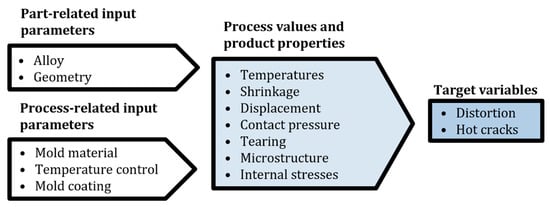
Figure 1.
The input parameters, measured variables, and the target variables are shown together.
Based on this, the test setup presented here was developed to investigate the deformation and the influences of the above input parameters. The following sub-objectives were defined for the development process:
- The test specimen geometry should allow for simple measurability of the resulting component distortion;
- In addition to the distortion-relevant area, another area with the possibility of free contraction must be provided in the component for comparison reasons;
- There should be a relatively easy possibility of modifying the mold for different geometries, locally different mold materials, temperature control solutions, etc.;
- Clearly defined directions and areas of heat extraction must be ensured in the mold;
- The integration of variably positionable thermocouples and the possibility of in-situ recording of relative movements between mold and casting as well as the attempt to locally measure the force acting on the component due to in-mold constraints must be implemented;
- A convenient procedure for the experimental work to investigate the influences on the distortion in the developed setup should be derived.
2. Materials and Methods
For the experimental setup to be developed, some framework conditions were de-fined, which result from practical considerations or the use of existing equipment. Thus, the common mold steel X38CrMoV5-1 (AISI H11) was selected as molding material. The use of two oil temperature control units (type 1502/12 by Thermobiel Apparatebau GmbH, Gladbeck, Germany) with a total of four circuits, that can be set up independently from ambient up to 350 °C medium temperature and with a flow rate of 16 l/min each, enables full thermal control. The die coating was selected to be KS-81 (by Hüttenes-Albertus, Düsseldorf, Germany) from the previous works [1,2,3]. The measuring devices to measure the relative movement of the part and the contact pressure were also adopted from these previous test setups, with which the gap and contact pressure dependent heat transfer coefficients were determined. This means that 16 temperature channels with type K thermocouples (TC Mess- & Regeltechnik GmbH, Mönchengladbach, Germany) were available. There are also eight channels for displacement measurements on each of which a Linear Variable Differential Transformer (LVDT) (Eddylab GmbH, Otterfing, Germany) can measure the displacement of the mold or casting via a quartz glass rod for thermal decoupling. Furthermore, there is a load cell (Lorenz Messtechnik GmbH, Alfdorf, Germany) with which the contact pressure due to shrinkage can be determined. The in-situ measured variables recorded in this way are stored at 20 Hz for later evaluation. Simulations with the commercial software MAGAMSOFT® version 5.3.1 (MAGMA Gießereitechnologie GmbH, Aachen, Germany) accompany the work on the thermal design phase of the test setup and the distortion investigations. They serve to consider the possibilities of the control concepts for distortion minimization. Like the experiments to investigate the heat transfer coefficient [1,2], the material chosen for the experiments was grain refined A356 (AlSi7Mg0.3) provided by Rheinfelden Alloys (Aluminium Rheinfelden Alloys GmbH, Rheinfelden, Germany), which is the industrial standard. In addition, many of the preceding studies considered this alloy, so the existing knowledge base is already very broad. Finally, a pouring temperature of 720 °C was chosen and 15 min of argon rinsing immediately before each casting was applied. This, as well as the pour time of 8 s, was kept constant across all experiments.
3. Results
The entire process of developing the experimental setup, the component geometry, the mold, and the design solutions is to be understood as a highly iterative process due to the many interdependencies of these working fields. The results of this process are presented here according to the following areas.
3.1. Geometry of Test Specimen
From the requirements listed above for the geometry of the cast component, a “U” results as a geometry that offers the demanded geometric constraints and therefore a hindering of the solidification shrinkage and the solid shrinkage by the mold. Further, it delivers convenient measurability, and the distortion can easily be determined as a two-dimensional quantity, because the opening width is a simple length to measure. The requirement to have an unhindered shrinking element as a reference to the “U” leads to an extension of the component to an “F” shaped geometry. The chosen dimensions are shown on the top left side of Figure 2. The boxed measure of 130 mm is the measured value to determine the component distortion. This geometry for the test specimen results in a component weight of 2.4 kg aluminum. The consideration of reducing the wall thickness of the test component, if necessary, to be able to generate higher temperature gradients from which more pronounced results are expected, led to the reduction of the wall thickness (Figure 2, top right). A CAD-model of the specimen with a height of 120 mm and with an inlet-feeder at the top is shown on the bottom of Figure 2.
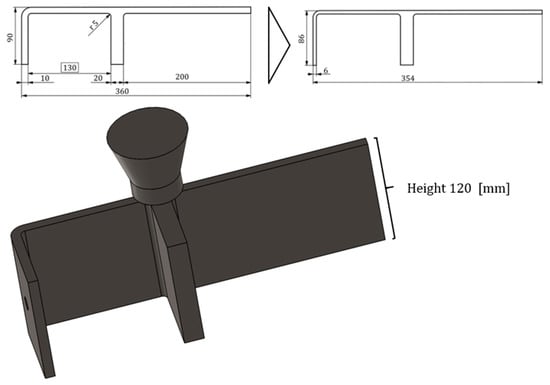
Figure 2.
On the top left, the geometry parameters for the test specimen with initial wall thickness and on the top right with its thin-walled configuration. On the bottom a CAD-model of the complete cast part with inlet-feeder.
3.2. Design of Experimental Setup
A cast iron grid plate was chosen as the basis for the test setup, which allows a variable design of the mold modules. The actual mold has been designed modularly, with one module each for the outside and inside of the U-shaped section, as well as one for each side of the free end (Figure 3 left). The four mold modules were designed in such a way that they have a constant wall thickness of 30 mm around the cast component, to ensure a uniform influence of the temperature control on the component. In order to ensure that the heat is extracted only in the horizontal direction, the mold modules are closed on the underside with an insulating calcium silicate (Calcast® CC60 by SILCA Service- und Vertriebsgesellschaft für Dämmstoffe mbH, Mettmann, Germany) plate. They are covered on the top with a furan resin sand lid with an integrated inlet-feeder and filter. This is shown in Figure 3 on the right. Each of the four modules contains one of the four independent temperature control circuits, which allows the different areas U-inside, U-outside, and the two sides of the free end to be temperature-controlled independently. The cooling channels run equidistant to the surface of the cavity and at equal intervals vertically through the modules, as it is the state of the art for permanent mold casting [20,21]. Figure 4 shows the four cooling circuits. Fastening points between the modules were designed in such a way that they have as little influence as possible. This modular design allows, for example, for the change of the geometry in the above-mentioned points by simply replacing modules of the mold. For the casting with the thinner wall thickness, the two outer parts must be changed, and for the other variations, the U-inside—which is called the core module from here on. In addition, locally different mold materials can be used (e.g., a sand core for the U-inside) or generatively manufactured modules with optimized cooling channel geometries can be integrated. This design allows for a high number of combinations of the modules and therefore a wide field of possible investigations.
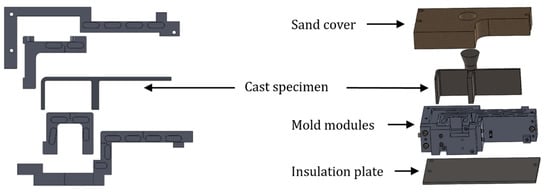
Figure 3.
On the left, the modular mold design can be seen, which allows changes to geometry, mold material, or other by exchanging individual modules. The right side shows the cast part, the assembled mold modules, and the calcium silicate bottom plate serving as insulator and the sand cover with integrated inlet-feeder.

Figure 4.
The four independent equidistant cooling circuits are shown in a plan view on the left and together with the test specimen in isometric view on the right.
For in-situ measurements, the selected measuring points are shown in Figure 5. For the thermocouples, the locations were selected so that one measuring point was located in the casting at each end of the cavity and three in the thicker middle rib. One is in the center of the wide section, one in a corner of this rib, and one in the middle between them. Two others were placed in the casting in such a way that a group of three possible measuring points are opposite of each of them in the mold to determine the heat balance at the cast-mold interface. One is in the free end, and one is in the connecting piece between the two ribs of the “U”. The displacement transducers were arranged as pairs, one measuring the displacements of the mold and the other the movement of the melt to derive the relative movement. The far side of the “U” was selected as the first measuring point (A), since here a clear displacement between component and mold is expected during solidification due to the hindered shrinkage. The second pair of displacement transducers measures the relative movement between component and mold on the outside of the “U”, where a gap is expected to form (B). The last two pairs measure the shrinkage of the free contracting area of the casting by measuring the movement of the free end (C) and the center rib (D). Furthermore, the load cell from the previous work was integrated on the inside of the “U” to determine the shrinkage force between component and mold (E) [1,2]. It should be noted that due to the amount of preparation required, not every measurement will be taken at every experiment. Figure 6 shows the mold assembled on its base using the maximum of simultaneously insertable measuring transducers.
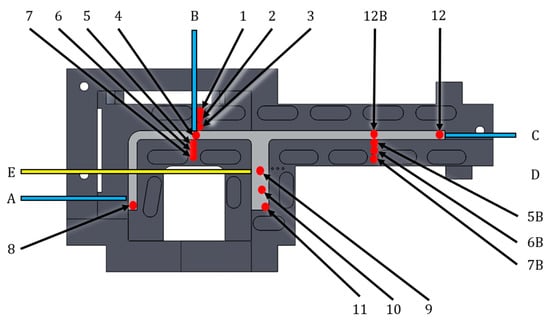
Figure 5.
Temperature measuring points (red) and the measuring points of the displacement transducer pairs (blue lines), as well as the point of application for the measurement of the shrinking force (yellow).
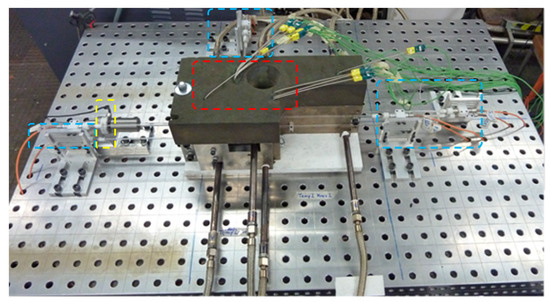
Figure 6.
Complete test setup prepared for the first test. The temperature measuring points (red), the displacement transducers (blue), and the load cell (yellow) are clearly visible.
3.3. Simulations and Optimized Cooling Channels
The entire conceptual and design development process was accompanied by numerical simulations performed with the foundry simulation software and the implemented permanent mold casting module. The focus was on the heat balance and its adjustability through temperature control. Since the materials and technologies used are conventional ones known from practical application, the material data and properties were taken from the program’s internal database. First, the resulting temperature profiles in the mold modules with cooling channels equidistant from the cavity were calculated for 45 min of temperature control (starting from room temperature) prior to the casting. Figure 7 above (A) shows the heat distribution in the mid-plane of the mold before casting for a temperature in the cooling circuits of 150 °C. The calculated heat distribution in the middle plane when 50% off the material has solidified after 13 s is shown for the mold at the bottom left (B) and for the casting at the bottom right (C) of Figure 7. It can be seen that the edges of the “U” are the hottest part in the mold and that in the casting the areas far away of the inlet are the coldest.
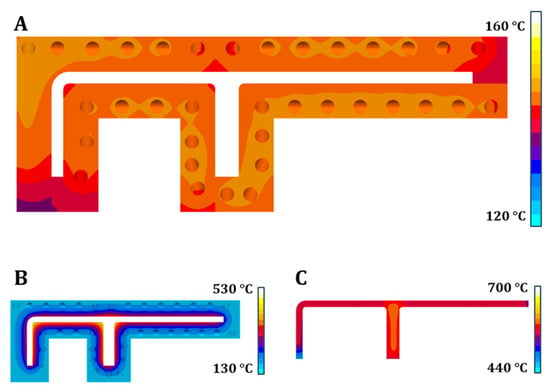
Figure 7.
On top (A) the heat distribution in the mold after 45 min of temperature control set to 150 °C. The calculated heat distribution in the middle plane when 50% off the material has solidified after 13 s are shown for the mold at the bottom left (B) and for the casting at the bottom right (C).
Furthermore, during tool design in cooperation with the Institute of Plastics Processing (IKV) at RWTH Aachen University, the transferability of a developed algorithm for plastic injection molding for the optimization of the cooling channel layout for a more homogeneous solidification was considered [7]. This was done to test the transferability of the hypothesis that a homogeneously solidifying component produces less distortion, which was found to be true in plastic injection molding, to metal casting. The influence of the calculated cooling channel layouts could not be correlated conclusively with the component distortion for metal castings in a numerical framework. It should be noted that the thermal conductivity of the plastics and aluminum considered differ by several orders of magnitude. Therefore, the implementation of adapted cooling channels in mold modules manufactured generatively by selective laser melting (SLM) was implemented as a step towards experimental validation.
Since generative manufacturing is very time-consuming and cost-intensive, only the core module with adapted cooling channels was manufactured. This area is chosen because during the cooling process, the casting shrinks onto the core module. The resulting contact pressure at the boundary surfaces produces a high heat transfer coefficient, and thus the best heat transfer between melt and mold compared to other areas of the mold [2]. On the other hand, the corners of the core module, with two-sided contact with the melt, form the most pronounced hot spots, as well as one of the coldest points of the mold at the far end of the “U” (see Figure 7). Restrictions in design were given by the practical feasibility of the geometry of the cooling channels, including the fact that the wall temperature of the cooling channels could not rise above the evaporation temperature of the heat transfer oil (Marlotherm® SH by Hüls AG, Stadt, Land) of 380 °C, which requires a minimum distance between the channels and the cavity. On the other hand, although the geometry of the cooling channels can be chosen freely, its manufacturability is limited by the SLM process and the necessary support structure during the manufacturing process. The cooling channel geometry created in this way can be seen in Figure 8 on the left. A comparison with the conventional geometry on the right shows that the adapted channels extend significantly into the corners of the core identified as hot spots. A significant amount of the channel length is placed towards the thicker center rib, while towards the end of the “U” the length of the cooling channel is significantly reduced.
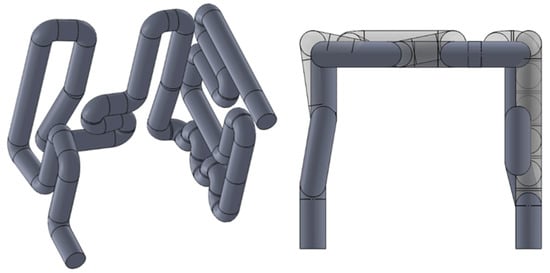
Figure 8.
The design of the cooling circuit in the SLM-manufactured core module on the left and on the right a top view where it can be seen that this circuit (here transparent) reaches further towards the corners of the core module than the conventional one (here solid).
Comparative simulations between the mold with the conventionally manufactured core and the generatively manufactured one, with adapted cooling channels, were carried out. The standard settings for the materials were used, with the following exceptions: The HTC between the core module and the castings was taken as a constant of 3500 W·m−²·K−1, which is closer to the real HTC for the case of shrinkage [2]. For the other areas, the temperature dependent HTC given in MAGMASOFT® (ranging from 2700 to 1000 W·m−²·K−1) was used. For the assembled mold modules, an HTC of 8000 W·m−²·K−1 was set at the interfaces, which was determined to be applicable for smoothed and bolted steel plates [22]. Simulations indicated that a mold temperature set as cold as possible shows the greatest effects for a different cooling channel layout. Therefore, the calculated temperature distribution in the center plane at the end of mold filling in a mold set to 30 °C is shown in Figure 9. On the left, the core with conventional, equidistant cooling channels is displayed and, on the right, the generatively manufactured core with adapted cooling channel design can be seen. It is noticeable that with the adapted cooling channels, the highest temperature is lower, and at the far end the lowest is a little bit higher. Thus, for the core with adapted channels, the range of the temperature distribution is less wide. The same calculations show a similar picture for 54 s after mold filling, when all material except the feeder has solidified. The core module, which has dissipated most of the heat shows that the core with the adapted cooling channel layout has less pronounced hot spots in the corners enclosed by the casting—this can be seen in Figure 10. Further investigations in the stress module of the software do not lead to any significant differences in the distortion of both castings for the two setups and are not considered further here.

Figure 9.
Temperatures at the end of pouring in the mid-plane of the cast part (U-section).
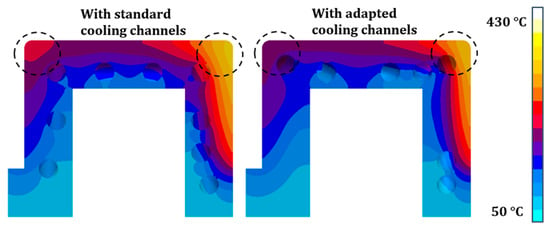
Figure 10.
The temperature distribution in the middle plane of the core module after 54 s of solidification when 80% of the material has solidified.
3.4. Experiments with the Different Cooling Channel Designs
The experiments in the initial geometry deliver components which have none to very little visible casting defects, apart from slight sink marks on the upper side. After demolding, the distortion was determined by measuring and averaging the opening width of the “U” at several measurement points. These measurements at the opening of the “U” showed a component distortion of approximately 1 mm widening in comparison to the dimension of the mold contour. The mold dimensions were used as the value for the optimal cast part geometry.
To investigate the influence of the cooling channel design, a series of five casts were made with each core. To generate the greatest possible effect from changing the cooling channel layout, the temperature control was set to 30 °C (see above). Furthermore, series of five castings were carried out with the thin-walled geometry with each core module. In this case, the mold was temperature controlled at 150 °C, since an even lower temperature caused cold runs. Figure 11 shows a demolded test specimen with the initial geometry, and the points for the component distortion measurements.
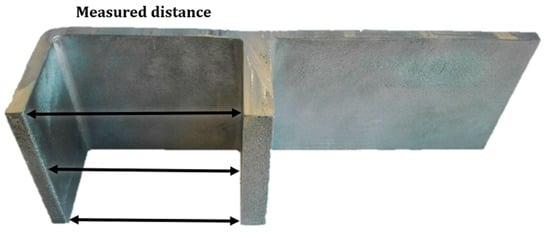
Figure 11.
A Cast specimen with the initial geometry. On the left the measuring points for the component distortion are shown.
In the experiments with the initial geometry, in-situ temperature curves were recorded at the measuring points (cf. Figure 5) in the mold and core (1–3 and 5–7) as well as in the casting (4 and 8–12). The temperatures within the casting do not show any other significant differences than the variations between the individual casts. However, the temperature curves in the mold (measuring points 1–3) and core module (5–7), on the other hand, show that in the case of the generatively manufactured core with adapted cooling channels, the temperatures rise after casting to a significantly hotter maximum. While the temperature distribution in the mold is at the same level for both versions after 200 s. The temperatures remain at a higher level on the core side for the core with the adapted cooling channels. This can be seen in Figure 12 on the left side for the measuring points in the mold (1–3) and on the right for the core module (measuring points 5–7). The values of the generative manufactured core module are labeled “SLM”. The displacement measurements as well as the results of the contact pressure measurements showed no correlation with the different variants of the core module and are therefore not further described. To close the causal chain of heat balance, solidification, microstructure, and component distortion, the microstructure of the components was examined metallographically. No significant differences in SDAS (secondary dendrite arm spacing) and grain sizes, neither locally within the components nor between the different castings, were found. Thus, the mean grain diameter is between 380 and 545 µm with a median of 439 and a standard deviation of 55.19 µm. The SDAS is between 16.7 and 24.4 µm with a median of 21.00 and a standard deviation of 2.08 µm. No evaluable correlations between parameter variation and sampling location were found.
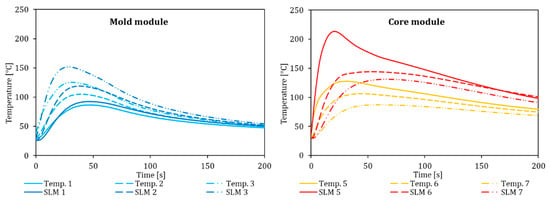
Figure 12.
In-situ measured temperatures of casting experiments in the initial geometry and temperature control set to 30 °C.
The evaluation of the distortion measurements on the components of the four test series considered here provides the respective distortion as an average value of the components of a series. For both types of geometry (standard or thin-walled) the average distortion for the variation of the core module with adapted cooling channels is significantly higher than for the variation with the conventional core module. For the conventional core module, it is at a very similar level of 0.62 mm for the standard and 0.62 mm for the thin-walled geometry. For the core module manufactured generatively by SLM, the standard geometry has a high distortion of 1.11 mm. The thin-walled geometry has a distortion of 0.93 mm, which is higher than that of the normal core module but lower than that of the standard geometry with the SLM core module. Furthermore, an examination of the standard deviations of the distortions determined shows that these are significantly lower for the adapted cooling channels than for those with the conventional core module. With 0.09 mm and 0.13 mm for the standard geometry, the standard deviation is lower than the thin-walled standard deviation with 0.17 mm and 0.31 mm, respectively. The respective mean distortions and standard deviations are shown graphically in Figure 13 on the left for the standard and on the right for the thin-walled geometry.
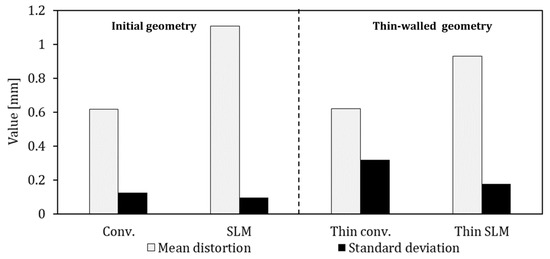
Figure 13.
Mean distortion and standard deviation for the different series.
4. Discussion
During commissioning of the setup, it turned out that the handling and especially the precise positioning of the thermocouples through the sand cover caused considerable difficulties and could not be achieved without sand abrasion entering the cavity. After cooling to room temperature, the casting was easy to remove without much resistance except for a slight shrinkage to the core module inside. This prevents further plastic deformations of the test specimen during demolding. The measurement of the distortion could be achieved by the simple use of a caliper at various points of the opening of the “U”, and the measurement accuracy was less than 0.05 mm. One to two castings per day could be achieved during the series of tests depending on the number of measuring devices installed. The limiting time factor was cooling down to room temperature and the renewal of the measurement devices, as the thermocouples and quartz rods protruding into the melt must be replaced after each casting.
The accompanying simulations showed that cooling channels adapted to the heat distribution in the component can somewhat reduce the occurrence of thermal extremes in the component and mold. This is much less pronounced when considering the modules that can be used in reality, as could be seen in the first purely numerical considerations of idealized cooling channel layouts [7]. The small extent of the expected differences makes a comparison of the measured in-situ values (here the temperature) with the calculated ones poorly possible. Important influential quantities such as the contact condition-dependent heat transfer between mold and component cannot be included at the current project status due to the non-quantifiable contact conditions. The simulation of the component distortion led to results that deviated strongly from reality, which is due to the cooling of the component in the mold down to ambient temperature before demolding, whereas the simulation refers to a practical manufacturing process where demolding temperatures are usually not below 300 °C [23].
The evaluation of the recorded in-situ measurements showed that both the temperature and distance measurements worked as expected, but the latter and some of the former showed no correlation with the investigated variation of the cooling channel design. Furthermore, the load cell provided no useful results for the shrinkage force at all. The inconclusive metallographic investigations fit with the current knowledge that for typical solidifications in permanent mold casting of thin-walled components, as given here by the wall thickness and the steel mold, no large local changes of SDAS and grain size are observed. This results from the fact that the achievable differences are very small in the overall context (the thermal conductivity of aluminum is high, so very rapid heat equalization occurs). Nevertheless, a temporal variance in local microstructure formation may be present, causing differences in the observed component deformation.
The meaningful measured values are the temperatures in the core module and at the measuring points exactly opposite to them in the mold. The fact that the temperature values in the core for the layout with adapted cooling channels are higher than those in the conventional core is consistent with the fact that the measuring points are at a place of the component with little mass (and thereby little heat capacity). Therefore, the cooling channels are further apart, in order to cause a slower solidification in the adapted layout compared to the conventional one. The fact is that for the core module with adapted cooling channels the temperatures measured in the mold are higher fits as well. This is because the smaller quantity of heat dissipated in the core causes greater heating of the opposite mold module. The fact that the temperatures in the adapted core module decrease more slowly after casting can also be explained by the more distant cooling channels in this area.
The fact that the mean distortions determined for the variation with adapted cooling channels are higher for both geometries than with equidistant ones refutes the hypothesis, valid in plastic injection molding, that a homogeneously solidifying casting results in less distortion in metal casting. This result, in combination with the fact of numerically poorly mappable distortion for room temperature demolding, suggests that the major portion of the distortion is formed during in-mold hindered solid shrinkage of the casting and not at the point of solidification, which is also indicated in literature [24].
The distortion considered here is caused by the shrinkage of the casting, which is hindered by the steel core, where the cores corners serving as abutments over which the legs of the “U” are pulled outward when the back of the “U” connecting them shrinks more than the core material. This can be explained by the thermal expansion coefficients of A356 for 2.15 × 10−5 K−1 at ambient temperature and 4 × 10−5 K−1 at 550 °C [11], compared to that of the core module material (X38CrMoV5-1) with 1 × 10−5 K−1, which averaged about the associated temperature range.
The fact that the mean distortion increases generally for the adapted cooling channels, and a more homogeneous solidification, can be interpreted appropriately in a way that a mechanically coherent dendrite structure is already present at a higher temperature. During cooling, since it has a mechanically loadable structure over a larger temperature interval, this develops more stresses—and thus distortion—when the mold constraint is removed, compared to the inhomogeneously solidifying component with more areas that are already solidified and at the same time still has liquid portions. This also fits with the larger dispersion of distortion within the series with conventional cooling channel layout. Here, the different local areas of the component start to develop mechanically loadable cohesion at different times. The standard deviation of the mean distortions for both component geometries in the variation with adapted cooling channels is significantly lower than in the variation with equidistant cooling channels. To illustrate this, Figure 14 schematically shows the semi-solidified component, once unevenly solidifying on the left and homogeneously solidifying on the right. On the left, almost completely solidified areas (A) occur simultaneously with areas that have not yet solidified (B), and no mechanical load can yet be absorbed and distributed. On the right, however, a coherent structure capable of bearing mechanical loads has already been formed. This shows that there is a usable correlation between more homogeneous solidification and component distortion in metal casting to minimize distortion.

Figure 14.
Schematic representation of the semi-solidified component, once unevenly solidifying (left) and once homogeneously solidifying (right).
Since the resulting mean distortions differ significantly in amount, it seems obvious to normalize their standard deviations with the mean distortion of the corresponding component series. In this way, a dimensionless value is obtained for this relative scatter as an evaluation criterion. For the experiment series considered here, this is shown in Figure 15. It can be seen that this value is lowest for the standard geometry and the variation with the SLM manufactured core module with the adapted cooling channels. This appears logical, since this was the design case for the layout of the adapted cooling channels. The value of 0.09 means that the standard deviation of the distortion of these series of components is a little less than one tenth of the mean distortion of all allocated specimens.
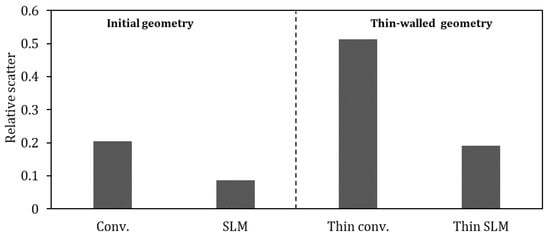
Figure 15.
Relative scatter for the different test series.
5. Conclusions
The first series of tests showed that both the component geometry and the mold design are well suited for the intended investigations. It was shown that only a small effect of the variations of the cooling channel geometry considered here reaches the aluminum casting. The large variations in the in-situ measurements in the component and the observed trends in the resulting component distortion suggest that the large number of disturbance variables inherent in the casting process have a significant influence on the component in question.
Furthermore, the experimental setup allows the study of the influence of component geometry, molding material, and other parameters by the simple exchange of modules. The relationship between temperature management and mold constraint and thus the variation of the demolding time as one of the main influencing variables on component distortion can also be investigated in a next step using modified mold modules.
Nevertheless, by adapting the cooling channels to the actual demand for local heat dissipation, it was possible to significantly reduce the relative scatter of the distortion at a higher average distortion. This suggests that for an optimal amount of distortion compensation, this has to be done geometrically, as is the state of the art. This is currently done mainly based on experience, which invites research in this direction on empirical and numerical basis. The combination of geometric and thermal compensation methods shown here to reduce the scatter seems to be a good way to improve the quality of the cast components.
Author Contributions
Conceptualization, N.W. and T.H.; methodology, N.W. and T.H.; software, N.W.; validation, N.W., T.H. and U.V.; formal analysis, U.V.; investigation, N.W.; resources, N.W. and T.H.; data curation, N.W.; writing—original draft preparation, N.W.; writing—review and editing, U.V., A.B.-P. and C.H.; visualization, N.W.; supervision, U.V., A.B.-P. and C.H.; project administration, U.V., A.B.-P. and C.H.; funding acquisition, U.V., A.B.-P. and C.H. All authors have read and agreed to the published version of the manuscript.
Funding
This research was funded by the Deutsche Forschungsgemeinschaft e.V. (DFG, German Research Foundation).
Acknowledgments
The presented investigations were carried out at RWTH Aachen University within the framework of the Collaborative Research Centre SFB1120-236616214 “Bauteilpräzision durch Beherrschung von Schmelze und Erstarrung in Produktionsprozessen” and funded by the Deutsche Forschungsgemeinschaft e.V. (DFG, German Research Foundation). The sponsorship and support are gratefully acknowledged.
Conflicts of Interest
The authors declare no conflict of interest. The funders had no role in the design of the study; in the collection, analyses, or interpretation of data; in the writing of the manuscript, or in the decision to publish the results.
References
- Wolff, N.; Pustal, B.; Vossel, T.; Laschet, G.; Bührig-Polaczek, A. Development of an A356 Die Casting Setup for Determining the Heat Transfer Coefficient Depending on Cooling Conditions, Gap Size, and Contact Pressure. Mater. Sci. Eng. Technol. 2017, 48, 1235–1240. [Google Scholar] [CrossRef]
- Wolff, N.; Ahamadein, M.; Pustal, B.; Bührig-Polaczek, A. Identification of relevant Parameters for a gap and pressure dependent heat transfer model for different cooling conditions in gravity die casting. In Proceedings of the Liquid Metal Processing & Casting Conference, Birmingham, UK, 8–11 September 2019; pp. 319–325. [Google Scholar]
- Wolff, N.; Zimmermann, G.; Vroomen, U.; Bührig-Polaczek, A. A Statistical Evaluation of the Influence of Different Material and Process Parameters on the Heat Transfer Coefficient in Gravity Die Casting. Metals 2020, 10, 1367. [Google Scholar] [CrossRef]
- Laschet, G.; Vossel, T.; Wolff, N.; Apel, M.; Bührig-Polaczek, A. Multiscale solidification simulation of an axisymmetrical A356 component in die casting. In Proceedings of the 6th Decennial Conference on Solidification Processing—SP17, Old Windsor, UK, 25–28 July 2017. [Google Scholar]
- Vossel, T.; Pustal, B.; Bührig-Polaczek, A. Modellierung der Erstarrungskinetik kolumnarer und äquiaxialer Kornstrukturen zur gefügebasierten Interpolation der Werkstoffeigenschaften im Hinblick auf die Verzugsvorhersage. Gießerei Spec. 2017, 2, 130–134. [Google Scholar]
- Hopmann, C.; Nikoleizig, P.; Dornebusch, H.; Schneppe, T. Minimization of Warpage for Injection Molded Parts by Inverse Thermal Mold Design. Int. Polym. Process. 2018, 33, 110–116. [Google Scholar] [CrossRef]
- Hopmann, C.; Schneppe, T.; Theunissen, M.; Bührig-Polaczek, A.; Wolff, N. Investigation on the transferability of algorithms for the numerical optimization of cooling channel design in injection molding on metal gravity die casting. Mater. Sci. Eng. Technol. 2017, 48, 1220–1225. [Google Scholar] [CrossRef]
- Motoyama, Y.; Takahashi, H.; Inoue, Y.; Shinji, K.; Yoshida, M. Development of a device for dynamical measurement of the load on casting and the contraction of the casting in a sand mold during cooling. J. Mater. Process. Technol. 2012, 212, 1399–1405. [Google Scholar] [CrossRef]
- Motoyama, Y.; Takahashi, H.; Inoue, Y.; Shinji, K.; Yoshida, M. Dynamic measurements of the load on castings and the contraction of castings during cooling in sand molds. J. Mater. Process. Technol. 2013, 213, 238–244. [Google Scholar] [CrossRef]
- Eskin, D.G.; Suyitno; Mooney, J.F.; Katgerman, L. Contraction of Aluminum Alloys during and after Solidification. Met. Mater. Trans. A 2004, 35, 1325–1335. [Google Scholar] [CrossRef]
- Macht, J.P.; Maijer, D.M.; Phillion, A.B. A Combined Numerical–Experimental Approach to Quantify the Thermal Contraction of A356 During Solidification. Met. Mater. Trans. A 2017, 48, 3370–3376. [Google Scholar] [CrossRef] [Green Version]
- Galles, D.; Monroe, C.; Beckermann, C. Measurement and Prediction of Stresses during Casting of a Steel Bar. In Proceedings of the 65th SFSA Technical and Operating Conference Proceedings, Chicago, IL, USA, 7–10 December 2011. Paper No. 5.5. [Google Scholar]
- Galles, D.; Beckermann, C. Measurement and Simulation of Distortion of a Steel Bracket Casting. In Proceedings of the 66th SFSA Technical and Operating Conference Proceedings, Chicago, IL, USA, 12–15 December 2012. Paper No. 5.2. [Google Scholar]
- Kang, J.-W.; Long, H.-M.; Wang, T.-J.; Huwang, T.-Y.; Liu, B.-C. Evaluation of distortion of castings. Int. J. Cast Met. Res. 2011, 24, 228–232. [Google Scholar] [CrossRef]
- Hofer, P.; Kaschnitz, E.; Schumacher, P. Simulation of distortion and residual stress in high pressure die casting—Modelling and experiments. Mater. Sci. Eng. 2012, 33, 012055. [Google Scholar] [CrossRef]
- Hofer, P.; Kaschnitz, E.; Schumacher, P. Distortion and Residual Stress in High-Pressure Die Castings: Simulation and Measurements. JOM 2014, 66, 1638–1646. [Google Scholar] [CrossRef]
- Garza-Delgado, A. Study of Casting Distortion and Residual Stresses in Die Casting. Ph.D. Thesis, Ohio State University, Columbus, OH, USA, 2007. Available online: https://etd.ohiolink.edu/apexprod/rws_etd/send_file/send?accession=osu1196175848&disposition=inline (accessed on 15 October 2021).
- Armillotta, A.; Baraggi, R.; Fasoli, S. SLM tooling for die casting with conformal cooling channels. Int. J. Adv. Manufact. Technol. 2014, 71, 573–583. [Google Scholar] [CrossRef] [Green Version]
- Kochan, D.; Seifert, E.; Miksche, R. Werkzeugoptimierung für thermische Abformverfahren. Z. Für Fabrikbetrieb 2012, 107, 302–306. [Google Scholar] [CrossRef]
- Seidel, G. Heizung und Kuehlung von Druckgiessformen. Anordnung und Auslegung der Umlaufkanaele. Giesserei 1978, 65, 308–313. [Google Scholar]
- Gorbach, P. Handbuch der Temperierung Mittels Flüssiger Medien; Regoplas: St. Gallen, Switzerland, 2006; pp. 118–124. [Google Scholar]
- Schmidt, F. Einsatz Variothermer Temperiersysteme im Aluminiumdruckguss. Ph.D. Thesis, RWTH Aachen University, Aachen, Germany, 2019. [Google Scholar] [CrossRef]
- Brunhuber, E. Leichtmetall- und Schwermetallkokillenguss; Fachverlag Schiele & Schön GmbH: Berlin, Germany, 1966; pp. 182–186. [Google Scholar]
- Campell, J. Castings, 2nd ed.; Butterworth-Heinemann: London, UK, 2003. [Google Scholar]
Publisher’s Note: MDPI stays neutral with regard to jurisdictional claims in published maps and institutional affiliations. |
© 2021 by the authors. Licensee MDPI, Basel, Switzerland. This article is an open access article distributed under the terms and conditions of the Creative Commons Attribution (CC BY) license (https://creativecommons.org/licenses/by/4.0/).